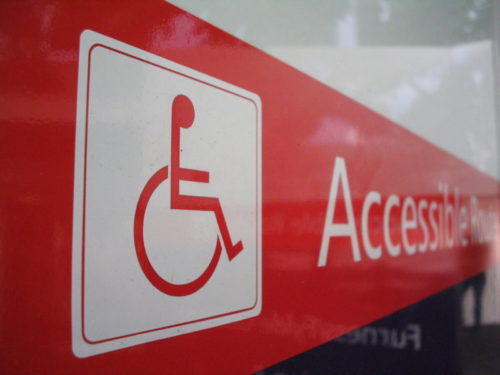You’ve probably heard the term “accessibility” at some point. But what does it actually mean?
Accessibility brings to mind different things for different people. Some picture a building with a wheelchair ramp, button-controlled doors, and elevators. Some think of Braille menus at restaurants and signs with tactile print on them in hotels. Others think of fire alarms which light up and make noise, or closed captioning on their televisions. In all of these cases, there is the common theme of making aspects of life easier, or possible, for people with disabilities, giving them the same information and level of access as everybody else.
The word “accessible” is commonly defined as “easy to approach, reach, enter, speak with, or use.” The majority of the definitions don’t even mention disability, or people with special needs! At its core, accessibility refers to the ability to access something, which is, not so coincidentally, exactly what the word sounds like when spoken!
For the purposes of this, and future blogs, accessibility to the web will be discussed primarily in the context of people with disabilities. In today’s ever connected world of technology, accessibility refers to the ability of all people to connect, browse, understand, and interact with a website, program or device. This includes turning on a device, successfully navigating its interface, correctly interpreting the content, operating its controls and submitting information. A website that is accessible allows a person to consume all of its content, and take advantage of all of its features, regardless of their disability.
Why is Accessibility Important?
Why should accessibility even be considered when discussing design and website strategy? To begin with, in Ontario, making websites accessible to everyone is the law! The Ontarians with Disabilities Act (AODA) was passed in 2005. According to AODA, all private sector businesses with fifty or more employees, as well as all public sector organizations, must make all new, or majorly updated public websites, accessible to persons with disabilities.
A website’s ability to connect with, and be accessible to, people with disabilities is of paramount importance if you take into consideration the following statistics from Stats Canada:
- Approximately 3.8 million Canadians 15 years of age or older reported being limited in their daily lives because of a disability in 2012.
- More than 80% of persons with disabilities in Canada use at least one disability aid or assistive device.
- 10.1% of working age Canadians reported having a disability, and 33.2% of seniors also reported having a disability.
As can be clearly extrapolated, having a disability is not an isolated phenomenon. As many as 3.8 million people in Canada may be unable to use a website that is inaccessible, compared to a website that is fully accessible. That’s 3.8 million people without crucial information, unable to keep up with social trends, and who cannot purchase specific products or services. As baby boomers continue to age, and the number of Canadians with disabilities continues to rise, a website that is accessible to both an “able” and “disabled” audiences will be far more successful than the ones that do not adopt this objective.
Accessible websites follow well-defined coding standards. This makes a website easier to maintain for developers, and easier for users of Assistive Technology to interpret. Google can more easily crawl through a website that is organized, properly tagged and standardized. And when Google understands content, it can more effectively direct it to relevant users, and will be more likely to place the website closer to the beginning of search results for related keywords.
With these reasons in mind, making websites accessible is the lawful, sensible, and compassionate thing to do. A website that is fully accessible will reach a wider audience, providing benefits for organizations, persons with disabilities, and society as a whole. Future articles in this series will dive deeper into web accessibility, providing examples of how to do it, how not to do it, and real cases of where accessible and inaccessible websites make a difference.
Contact Collaborative Haus Marketing, your tech accessibility partner, to learn more.





